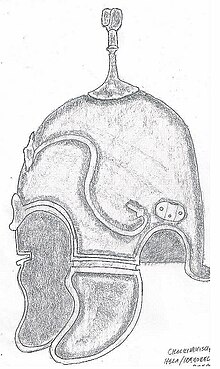Chalcidian helmet
| Chalcidian helmet | |
|---|---|

|
|
| Information | |
| Weapon type: | Protective weapon |
| Designations: | Chalcidian helmet |
| Use: | helmet |
| Working time: | about 500 BC Chr. |
| Region of origin / author: |
Greece , armory |
| Distribution: | Greece |
| Lists on the subject | |
A Chalcidian helmet is a protective weapon from Greece.
description
A Chalcidian helmet is usually made of bronze . The helmet bowl is slightly narrow and elongated, a ridge runs over the top. The side surfaces of the helmet bowl are bevelled, the nose iron is narrow and short, the cheek flaps are relatively large and reach down deep. They are rounded at the bottom. The helmet has ear cutouts and a neck shield, the eyebrows are worked out in high relief . A soldered edge strip runs around the edge of the helmet . A fork (bush fork) is placed on the top of the helmet, which is used to attach a helmet ornament ( zimier ). Some Greek helmets have a square hole in one of the cheek flaps that came from a nail punch . These copies are evidence of a consecration in a sanctuary. The helmet is about 19 cm high and weighs about 600 grams.
Versions
- Chalcidian helmet Iberoceltic special shape
A Chalcidian helmet, even in its special Iberoceltic form , is usually made of bronze . He has a hemispherical helmet bell. The front of the helmet is worked out in the shape of a mask, the eye cutouts and the cheek flaps are reinforced by soldered bronze bands. The cheek flaps are attached to the helmet with hinges . The cut-outs for the ears are round and about 2 cm, over which there are grommets for a helmet bush. A decorative ribbon is soldered onto the helmet's forehead, which is curved and ends in snake heads . A fastening ring is attached in the middle. A tall, U-shaped crest holder, which is riveted to the helmet bell, is attached to the crest line. There are versions of the helmet in which horns made of sheet bronze are attached to the helmet. There are several versions of the helmet, which differ in shape and decoration. The difference to the Chalcidian helmet lies in the execution of the decorations, the helmet ornament as well as the movable cheek flaps.
literature
- Ada Bruhn de Hoffmeyer: Arms & armor in Spain. A short survey. Volume 1: The Bronze Age to the end of High Middle Ages (= Gladius. Tomo espec 1971, ZDB -ID 188063-9 ). Instituto de Estudios sobre Armas Antiguas, Granada 1972, pp. 22-24.
- Petros Dintsis: Hellenistic helmets (= Archaeologica 43). G. Bretschneider, Rome 1986, ISBN 88-85007-71-6 (also: Wien, Univ., Diss., 1982).
- Hermann Pflug : Antique helmets (= art and antiquity on the Rhine. No. 129). Rheinland-Verlag, Cologne 1989, ISBN 3-7927-1112-5 .
- Holger Baitinger: The attack weapons from Olympia (= Olympic research. Vol. 29). Walter de Gruyter, Berlin et al. 2001, ISBN 3-11-016999-1 , p. 245.
Individual evidence
- ↑ Website of Hermann Historica, Munich, available online, (German, accessed on February 12, 2011) ( Memento from August 2, 2012 in the web archive archive.today )
- ^ Hermann Born: Restoration of antique bronze weapons (= Axel Guttmann Collection 2). Verlag Collection Guttmann at Philipp von Zabern, Mainz 1993, ISBN 3-8053-1614-3 , Example XIV (AG 356).
Web links
- [1] , [2] , [3] , various Chalcidian helmets from Hermann Historica, Munich
- Chalcidian helmet, Iberoceltic special form at Hermann Historica / Munich
- Chalcidian helmet, Iberoceltic special form at Hermann Historica / Munich
